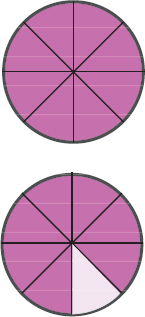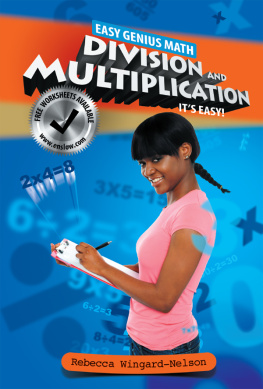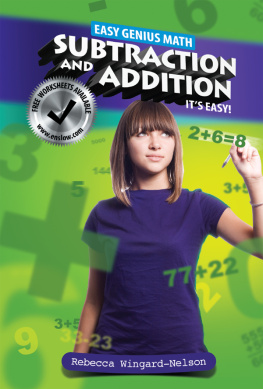DON'T SWEAT THE TEST! Having a problem with math? Nervous about your test? This book introduces all the topics you need to know about fractions and decimals. Learn great test-taking tips for solving multiple choice, short-answer, and show-your-work questions. A great book for students to use on their own, or with parents, teachers, or tutors.
"This book does a splendid job of clearly presenting material to help readers practice their test-taking skills in fractions and decimals."
Patricia Leonard, MS, Series Math Consultant,
Middle School Math Professional
Need More Practice?
FREE WORKSHEETS AVAILABLE AT ENSLOW.COM
About The Author
AUTHOR REBECCA WINGARD-NELSON has worked in public, private, and home-school mathematics education. She has been involved in various educational math projects, including developing and writing state assessment tests, exit exams, and proficiency tests, as well as writing and editing textbooks and workbooks.

Most of the topics that are found on math tests are taught in the classroom. Paying attention in class, taking good notes, and keeping up with your homework are the best ways to be prepared for tests.
Use test preparation materials, such as flash cards and timed worksheets, to practice your basic math skills. Take practice tests. They show the kinds of items that will be on the actual test. They can show you what areas you understand, and what areas you need more practice in. Relax. Eat a good meal.
Go to bed early enough to get a good nights sleep. Dont cram on new material! Review the material you know is going to be on the test. Get what you need ready. Sharpen your pencils, set out things like erasers, a calculator, and any extra materials, like books, protractors, tissues, or cough drops. Get up early enough to eat breakfast and not have to hurry. Wear something that is comfortable and makes you feel good.
Listen to your favorite music. Get to school and class on time. Stay calm. Stay positive. Before you begin, take a deep breath. Focus on the test, not the people or things around you.
Remind yourself to do your best, and not to worry about what you do not know. Work through the entire test, but dont spend too much time on any one problem. Dont rush, but move quickly first, answering all of the questions you can do easily. Go back a second time and answer the questions that take more time. Read each question completely. Read all the answer choices.
Eliminate answers that are obviously wrong. Read word problems carefully, and decide what the problem is asking. Check each answer to make sure it is reasonable. Estimate numbers to see if your answer makes sense. Concentrate on the test. Stay focused.
If your attention starts to wander, take a short break. Breathe. Relax. Refocus. Dont get upset if you cant answer a question. Mark it, then come back to it later.
When you finish, look back over the entire test. Are all of the questions answered? Check as many problems as you can. Look at your calculations and make sure you have the same answer on the blank as you do on your worksheet. Three common types of test problems are covered in this book: Multiple Choice, Show Your Work, and Explain Your Answer. Tips on how to solve each, as well as common errors to avoid, are also presented.
Any part of a whole is called a fraction.Any part of a whole is called a fraction.
A fraction can be part of one whole thing, or part of a whole group.Eight girls spent Friday night at a slumber party. Only three of the girls went to sleep. Write a fraction to describe the number of the girls who slept.Step 1: How many girls are in the whole group? 8. The number 8 is the bottom number, or denominator.  Step 2: How many of the girls went to sleep Friday night? 3.
Step 2: How many of the girls went to sleep Friday night? 3.  denominator: The bottom number in a fraction.
denominator: The bottom number in a fraction.  denominator: The bottom number in a fraction.
denominator: The bottom number in a fraction.
It tells the total number of equal parts.numerator: The top number in a fraction. It tells the number of parts being talked about.

 Which fraction can be used to tell how much of the large triangle is colored?
Which fraction can be used to tell how much of the large triangle is colored?
When you can find the solution to a multiple choice question quickly, mark the answer and move on. This problem gives you a picture of a large triangle. It is made of four triangular sections that are the same size. The denominator of the fraction is 4. One of the four sections is colored.
The numerator (top number) is 1. Solution: The correct answer is a. Mark it, and move on.
Fractions are written using a fraction bar or a slash. proper fraction: A fraction whose numerator is less than its denominator. Example: 4/9improper fraction: A fraction whose numerator is equal to or greater than its denominator. Example: 8/5 or 5/5Write an improper fraction to show how many large squares are shaded in color.
proper fraction: A fraction whose numerator is less than its denominator. Example: 4/9improper fraction: A fraction whose numerator is equal to or greater than its denominator. Example: 8/5 or 5/5Write an improper fraction to show how many large squares are shaded in color. Step 1:
Step 1: The denominator of an improper fraction is the number of equal parts in one whole.
How many equal parts are there in one whole square? 4. This is the denominator.  Step 2: How many of the equal parts are shaded? 11. The number 11 is the top number, or numerator.
Step 2: How many of the equal parts are shaded? 11. The number 11 is the top number, or numerator. 
 Pizzas are cut into eight equal slices each. When Jorges family was finished eating, there were still 15 slices left.
Pizzas are cut into eight equal slices each. When Jorges family was finished eating, there were still 15 slices left.
Write an improper fraction to show how many pizzas were left. A sketch could help you understand this problem. Each pizza is cut into eight equal slices. Draw a pizza with 8 slices. You need to have 15 slices left. Draw another pizza with 8 slices. Now there are 16 slices.
That is enough. Shade 15 of the slices. Now write the improper fraction. Remember, the denominator in an improper fraction is the number of equal parts in ONE whole. The denominator is 8. There are 15 slices left.
The numerator is 15. Write the answer in a full sentence.  Solution: When Jorges family was finished eating, there were 15/8 pizzas left.
Solution: When Jorges family was finished eating, there were 15/8 pizzas left.
Questions that ask you to show how you found the solution are sometimes called Show Your Work or Short Answer questions. Showing your work and showing some effort will earn you part of the credit, even if you have the wrong answer. The right answer, without showing some work, may only give you partial credit.














 Most of the topics that are found on math tests are taught in the classroom. Paying attention in class, taking good notes, and keeping up with your homework are the best ways to be prepared for tests.
Most of the topics that are found on math tests are taught in the classroom. Paying attention in class, taking good notes, and keeping up with your homework are the best ways to be prepared for tests.  Step 2: How many of the girls went to sleep Friday night? 3.
Step 2: How many of the girls went to sleep Friday night? 3.  denominator: The bottom number in a fraction.
denominator: The bottom number in a fraction. 
 Which fraction can be used to tell how much of the large triangle is colored?
Which fraction can be used to tell how much of the large triangle is colored? When you can find the solution to a multiple choice question quickly, mark the answer and move on. This problem gives you a picture of a large triangle. It is made of four triangular sections that are the same size. The denominator of the fraction is 4. One of the four sections is colored.
When you can find the solution to a multiple choice question quickly, mark the answer and move on. This problem gives you a picture of a large triangle. It is made of four triangular sections that are the same size. The denominator of the fraction is 4. One of the four sections is colored.  proper fraction: A fraction whose numerator is less than its denominator. Example: 4/9improper fraction: A fraction whose numerator is equal to or greater than its denominator. Example: 8/5 or 5/5Write an improper fraction to show how many large squares are shaded in color.
proper fraction: A fraction whose numerator is less than its denominator. Example: 4/9improper fraction: A fraction whose numerator is equal to or greater than its denominator. Example: 8/5 or 5/5Write an improper fraction to show how many large squares are shaded in color. Step 1: The denominator of an improper fraction is the number of equal parts in one whole.
Step 1: The denominator of an improper fraction is the number of equal parts in one whole.  Step 2: How many of the equal parts are shaded? 11. The number 11 is the top number, or numerator.
Step 2: How many of the equal parts are shaded? 11. The number 11 is the top number, or numerator. 
 Pizzas are cut into eight equal slices each. When Jorges family was finished eating, there were still 15 slices left.
Pizzas are cut into eight equal slices each. When Jorges family was finished eating, there were still 15 slices left. Solution: When Jorges family was finished eating, there were 15/8 pizzas left.
Solution: When Jorges family was finished eating, there were 15/8 pizzas left.